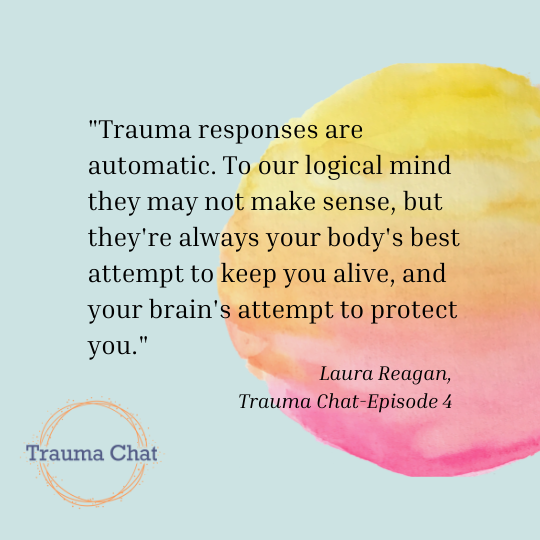Trauma Is Common and Confusing
Trauma is incredibly common, yet we seldom recognize the effects of trauma on the body. We simply operate in reaction to our emotions. Sometimes without much conscious awareness of what drives our behavior. Probably one of the most confusing things about being a trauma survivor is that our trauma reactions can come up. These responses are seeming without warning, and we immediately ignore them. We find ourselves reacting to what is happening inside of us. This is done without realizing our response is not really about what’s going on at this moment. However, we are reliving a past experience that feels like it’s taking place in the present.
In Episode 3 of Trauma Chat, host Laura Reagan, LCSW-C explained some of the common ways that unresolved trauma shows up in our lives. In Episode 4 of Trauma Chat Laura led listeners through a discussion. This is of the four threat defense reactions that come up in response to danger.
Trauma Reactions Pop Up When We Least Expect Them
During a traumatic experience – which we are defining as an event that overwhelms our nervous system – our brains and bodies kick into survival mode. Our trauma responses – our nervous system’s threat response system – activate. These instinctive trauma reactions happen instantly, outside of our conscious awareness. Our thinking brain, or our cognitive brain, isn’t a part of the decision-making process.
In other words, we are not reasoning to decide the best way to escape from the situation. Rather, our brain immediately activates one of four threat responses to help us to get away, fight back, or minimize harm to ourselves. Ultimately, this depends on the situation. We can’t even access the thinking. This is because, the logical part of our brain in these moments – which is a clue that a trauma reaction is beginning.
Why Do These Trauma Responses Happen?
These automatic reactions protect us and help us survive during life-threatening experiences. This includes situations that are we experience by the brain at the moment as being life-threatening, even if our cognitive brain may tell us that our life was never actually in danger.
What are the four Defenses?
The four automatic defenses activated during traumatic experiences are fight, flight, freeze, and submit. Most people have heard about fight or flight, but the other two responses, freeze and submit, are less well-known. Read on below to learn more about these trauma reactions including how they feel and what behaviors we may see when one of the survival defenses is starting.

Understanding Our Brain’s Automatic Trauma Reactions
Fight→ When our nervous system detects a threat, sometimes our fight instinct activates. This might look like verbally protesting, physically pushing or pulling, refusing to move, hitting, kicking. Fight can also look like someone expressing anger, rage, or defiance, arguing, and being continually oppositional.
Flight→ In a flight response, our body mobilizes to run away or remove us from a dangerous situation as quickly as possible. We may walk, run or use some form of transportation to escape danger. When we are unable to physically escape, the effect of trauma on the body involves going into Freeze mode (see below). While we may mentally escape by way of dissociation, our mind doesn’t, In fact, your mind may “go away” while our body experiences the event.
Benefits of Understanding the Flight Phase
However, while flight can look like all of these behaviors, it’s not always visible to the outside observer. Sometimes we turn our fight response inward. When our fight response is turned inward, it can show up differently. For example, in self-harming behaviors, eating disorders, isolation, self-loathing, and other self-destructive behaviors, including suicide attempts.
Freeze→ In a freeze response, internally we are filled with energy and adrenaline (which can feel like extreme anxiety). However, we are not able to motivate ourselves to action. One’s thoughts may be very active, but we may appear very still, stuck, and paralyzed.
It may seem off that a freeze response would be one of our natural trauma reactions. IN fact, freezing may not seem like something that would help us escape danger. However, freezing is an adaptive response, just like fight or flight, that can be very useful in life-threatening situations.
Let’s About This in Relation to the Freeze Response

Since humans are mammals, it makes sense to think about how this shows up in nature. When an antelope has tried to escape a lion by running away and the lion catches it anyway, it may collapse in the lion’s mouth, appearing to be dead. Because lions like to play with their prey before killing them, they may drop the antelope and nudge it, hoping it will attempt to fight back. When the lion turns its back, the antelope may suddenly revive and run-off.
This example illustrates that the adaptive freeze response allows one to appear to be very still, but internally the body is flooded with adrenaline to allow a quick escape when the opportunity presents. Our mind may “go away” while our body experiences the event. We may or may not have conscious memory of what happens when we dissociate during the traumatic experience, which creates extreme confusion when we begin to cognitively process the experience after the danger has passed.
Submit→ Submit is another very adaptive trauma response that can be very confusing after the fact. In a submit response, a person will engage with the person who is putting them in danger in order to show them that they are not a threat and to discourage the dangerous person from hurting them.
A submit response can look like compliance, sometimes even beyond the initial demand of a person who is harming us. For example, if you were robbed by someone who displayed a weapon and demanded your wallet, you might use words to show the person that you are not a threat, perhaps even volunteering to assist them in getting away with the crime or offering more of your personal belongings than they demanded initially.
With the Submit Response, It’s Important to Know…
It is not uncommon for people who are being held against their will to “submit” by apparently complying, even with the physical appearance of being a willing participant, as a way of surviving a situation that they are unable to escape. This often confuses people who may be unfamiliar with trauma responses, leading them to assume the person really was a willing participant despite the person disclosing their perception of this event like a violent incident and displaying trauma symptoms. In nature, submit is similar to a prey animal displaying its belly to a predator, to charm the predator into seeing them as less of a threat and hopefully moving on to hunt a more challenging prey.
Why is it important to understand fight, flight, freeze, and submit?
When we look at traumatic events, often we may not think about their response. Therefore, it’s common to judge oneself for the way we felt and behaved, And, how we feel and behave after the event has passed. Trauma, by its nature, is so overwhelming and confusing. When trauma reminders arise unexpectedly, we sometimes unconsciously re-live our reactions to the experience. This can happen no matter if we try to push away the unwanted, uncomfortable thoughts and emotions. Therefore, the effect of trauma on the body can cause us to feel out of control.
Learning About the Effect of Trauma on The Body Matters!
Learning about trauma reactions and how they show up in our lives is an important part of recognizing how we are impacted by trauma. This also aids in letting go of shame and self-blame about what we did or didn’t do during a traumatic experience. It’s important to give ourselves compassion and trust that we are always trying to do our best in every situation. If you’ve experienced a traumatic experience and are bothered by trauma reactions that won’t go away, PTSD treatment and trauma therapy can help. Together, a trauma therapist near you can help you understand the effects of trauma on the body more clearly!

To learn more about the four different trauma responses, listen to the full episode 4 of Trauma Chat here.
Find a Trauma Therapist in Our Directory to Better Understand the Effects of Trauma on the Body
If you’re ready to find the trauma therapist that is going to help you have a breakthrough then check out our online therapy directory. Know that we are regularly adding therapists to our directory. Therefore, the list will only continue to grow. To get started follow these steps:
- Head to our find a therapist page.
- Begin looking for a therapist in your area and select one that is a good fit.
- Visit their website and learn about our therapists.
- Get in touch and begin finding hope and healing!
*If you’re a trauma therapist who offers support for clients in understanding the effects of trauma on the body, our directory is for you. Visit our page to get set up as a therapist today!
Links for Understanding the Effects of Trauma on the Body:
- Leave a message with a question to be included in a future episode: https://www.speakpipe.com/traumachatpod
- Follow Trauma Chat on Instagram: www.instagram.com/traumachatpod
- Follow Trauma Therapy Coaching & Consulting on Facebook: www.facebook.com/traumatherapyconsulting
- Get more information on Trauma Chat at: www.traumachatpod.com. Sign up for the email list to stay in touch and receive a free gift!
- Find A Trauma Therapist Near You: www.traumatherapistnetwork.com – a community for finding information, resources and help for trauma.
- To listen to Laura’s other podcast, Therapy Chat, go to: www.therapychatpodcast.com
- If you like Trauma Chat please go to iTunes https://podcasts.apple.com/us/podcast/trauma-chat-podcast/id1571301677 and leave a rating and review and subscribe to receive each episode as soon as it comes out.




